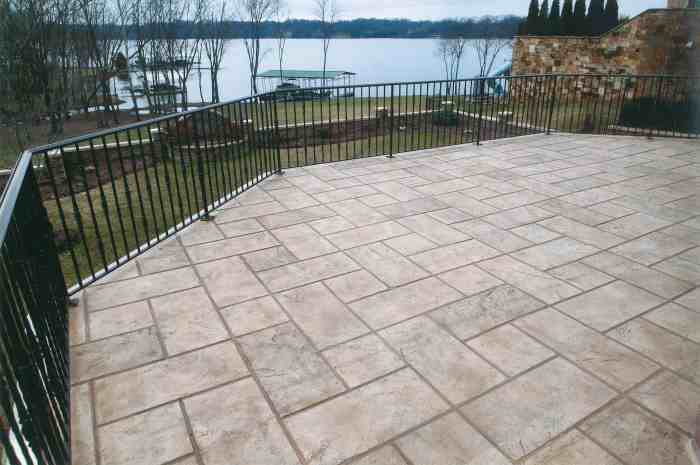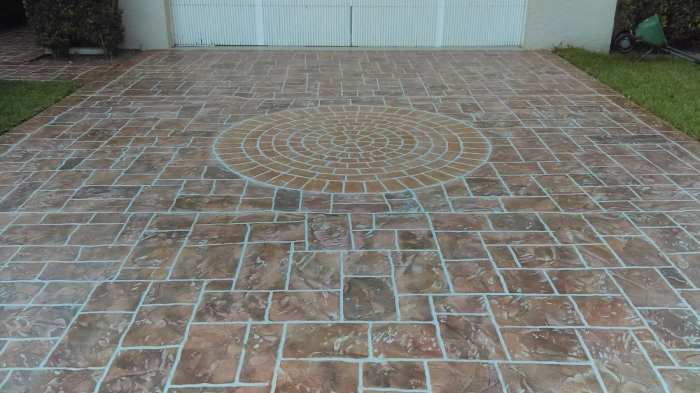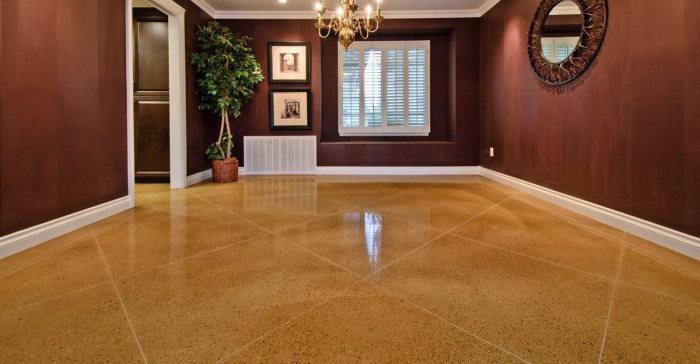Embark on a journey of bathroom transformation with decorative concrete overlays, the ultimate solution for elevating your space’s aesthetics and functionality. From sleek and modern to classic and timeless, these overlays offer a versatile canvas for your creative vision.
In this comprehensive guide, we will delve into the world of decorative concrete overlays, exploring their types, design considerations, installation methods, maintenance techniques, and troubleshooting tips. Prepare to unlock the potential of your bathroom, turning it into an oasis of style and comfort.
Types of Decorative Concrete Overlays for Bathroom Floors
Decorative concrete overlays are a popular choice for bathroom floors due to their durability, affordability, and wide range of design options. They are available in a variety of types, each with its own advantages and disadvantages.
Types of Decorative Concrete Overlays
- Stamped Concrete: Stamped concrete is created by pressing a mold into fresh concrete, which creates a textured surface that resembles natural materials such as stone, brick, or tile. Stamped concrete is durable and easy to maintain, but it can be more expensive than other types of overlays.
- Stained Concrete: Stained concrete is created by applying a chemical stain to the surface of the concrete. This creates a translucent color that allows the natural texture of the concrete to show through. Stained concrete is less durable than stamped concrete, but it is also less expensive.
- Polished Concrete: Polished concrete is created by grinding and polishing the surface of the concrete until it is smooth and reflective. Polished concrete is very durable and easy to clean, but it can be more expensive than other types of overlays.
- Epoxy Concrete: Epoxy concrete is created by mixing epoxy resin with concrete. This creates a very durable and chemical-resistant surface that is ideal for commercial applications. Epoxy concrete is more expensive than other types of overlays, but it is also the most durable.
The following table compares the properties and suitability of each type of decorative concrete overlay for bathroom floors:
| Type | Durability | Cost | Maintenance | Suitability for Bathrooms |
|---|---|---|---|---|
| Stamped Concrete | High | Moderate | Moderate | Good |
| Stained Concrete | Moderate | Low | Low | Good |
| Polished Concrete | High | High | Low | Good |
| Epoxy Concrete | Very High | High | Low | Excellent |
Design Considerations for Decorative Concrete Overlays in Bathrooms
Incorporating decorative concrete overlays into bathroom flooring offers a plethora of design possibilities. When selecting colors, patterns, and textures, it’s crucial to consider the overall bathroom décor to achieve a cohesive and stylish design. Slip resistance and durability are also paramount considerations for bathroom flooring, ensuring safety and longevity.
Color Selection
The color of the concrete overlay should complement the bathroom’s color scheme. Neutral hues like beige, gray, or white provide a versatile backdrop for various décor styles. Bold colors like navy, emerald green, or burgundy can create a dramatic statement.
Consider the size of the bathroom; darker colors tend to make smaller spaces feel more intimate, while lighter colors create an airy and spacious ambiance.
Pattern and Texture
Patterns and textures add visual interest to concrete overlays. Stenciled designs, stamped patterns, or troweled finishes can mimic the look of natural stone, tile, or wood. Choose patterns that complement the bathroom’s overall style, such as geometric designs for a modern bathroom or floral motifs for a traditional space.
Textures can add depth and character, creating a tactile experience underfoot.
Slip Resistance
Slip resistance is essential for bathroom flooring, especially in areas prone to moisture. Decorative concrete overlays can be enhanced with additives or textured finishes to increase friction and prevent slips. Consider using non-slip aggregates or applying a clear, slip-resistant coating over the overlay for added safety.
Durability
Bathrooms are subject to moisture, wear, and tear. Decorative concrete overlays should be durable enough to withstand these conditions. Choose overlays with a high compressive strength and abrasion resistance. Proper sealing and maintenance can further enhance the longevity of the flooring.
Cohesive Design
To create a cohesive bathroom design, consider the interplay between the concrete overlay and other elements such as tiles, fixtures, and accessories. Match the overlay’s color and texture to the bathroom’s overall aesthetic. For example, a gray concrete overlay with a stone-like texture can complement a bathroom with marble tiles and chrome fixtures.
Installation Methods for Decorative Concrete Overlays
Installing decorative concrete overlays on bathroom floors requires careful preparation, application, and finishing techniques. Here’s a detailed guide to ensure a successful installation:
Subfloor Preparation
1. Remove any existing flooring, adhesives, and debris.
2. Repair any cracks or unevenness in the subfloor using a suitable patching compound.
3. Clean the subfloor thoroughly to remove dust, dirt, and oils.
4. Apply a bonding agent to enhance adhesion between the overlay and subfloor.
Overlay Application
1. Mix the decorative concrete overlay according to the manufacturer’s instructions.
2. Apply the overlay to the prepared subfloor using a trowel or squeegee.
3. Spread the overlay evenly, ensuring it fills any voids or imperfections.
4. Allow the overlay to cure for the recommended time, typically 24-48 hours.
Surface Finishing
1. Grind the cured overlay to smooth the surface and remove any excess material.
2. Seal the overlay using a clear or colored sealer to protect it from moisture and stains.
3. Apply a non-slip coating for safety and prevent falls in wet conditions.
Safety Precautions
Wear appropriate safety gear, including gloves, safety glasses, and a dust mask.
Ensure adequate ventilation to prevent inhalation of dust or fumes.
Follow the manufacturer’s instructions carefully to avoid any potential hazards.
Maintenance and Care for Decorative Concrete Overlays in Bathrooms
Preserving the beauty and longevity of decorative concrete overlays in bathrooms requires proper maintenance and care. Follow these guidelines to ensure your overlay surface remains pristine and protected.
Regular cleaning is crucial to prevent dirt and grime buildup. Use a mild soap solution and a soft cloth or sponge for gentle cleaning. Avoid abrasive cleaners or harsh chemicals that can damage the overlay surface.
Sealing and Protection
- Seal the overlay surface periodically to protect it from moisture and stains. Use a penetrating sealer specifically designed for concrete overlays, following the manufacturer’s instructions.
- Apply a protective coating or wax to enhance the overlay’s resistance to wear and tear. Choose a product suitable for bathroom environments and follow the manufacturer’s guidelines for application.
Frequency of Maintenance
The frequency of maintenance depends on the usage and condition of the overlay. Regular cleaning should be performed as needed, typically weekly or bi-weekly. Resealing and reapplying protective coatings should be done every 6 to 12 months, or more frequently in high-traffic areas.
Additional Tips
- Use bath mats or rugs to absorb excess moisture and prevent water damage.
- Avoid standing water on the overlay surface for prolonged periods.
- If spills occur, clean them up promptly to prevent staining.
Troubleshooting Common Issues with Decorative Concrete Overlays in Bathrooms
Decorative concrete overlays in bathrooms are generally durable and long-lasting, but like any other flooring material, they can encounter certain issues. Identifying and addressing these problems promptly can help maintain the aesthetic appeal and functionality of the overlay.
Cracking
- Cause: Improper installation, inadequate subfloor preparation, or excessive weight on the overlay.
- Solution: Ensure proper subfloor preparation, follow installation instructions carefully, and avoid overloading the overlay.
Peeling
- Cause: Poor adhesion due to inadequate surface preparation, moisture issues, or incompatible materials.
- Solution: Prepare the surface thoroughly, address any moisture problems, and use compatible materials.
Discoloration
- Cause: Exposure to UV rays, chemical spills, or improper cleaning methods.
- Solution: Use UV-resistant sealers, clean the overlay properly, and avoid using harsh chemicals.
Moisture Damage
- Cause: Water seeping through cracks or improper sealing.
- Solution: Seal the overlay properly and address any cracks promptly to prevent moisture penetration.
Efflorescence
- Cause: Moisture carrying salts to the surface, resulting in white or crystalline deposits.
- Solution: Use moisture barriers, ensure proper drainage, and clean the efflorescence promptly.
Final Conclusion
As you embark on your decorative concrete overlay journey, remember that the possibilities are endless. Embrace your creativity, experiment with colors, patterns, and textures, and create a bathroom that truly reflects your unique style. With proper maintenance and care, your decorative concrete overlay will continue to grace your bathroom for years to come, providing a beautiful and durable foundation for your daily rituals.



